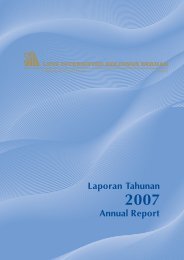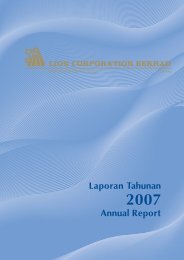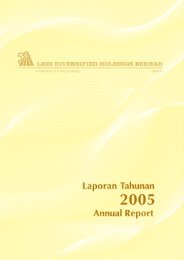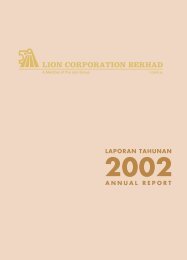continued - The Lion Group
continued - The Lion Group
continued - The Lion Group
You also want an ePaper? Increase the reach of your titles
YUMPU automatically turns print PDFs into web optimized ePapers that Google loves.
3. SIGNIFICANT ACCOUNTING POLICIES (<strong>continued</strong>)<br />
(o) Provisions, Contingent Liabilities and Contingent Assets<br />
Provisions are recognised when the <strong>Group</strong> has a present obligation as a result of a past event and it is<br />
probable that an outflow of resources embodying economic benefits will be required to settle the obligation,<br />
and a reliable estimate of the amount can be made. Provisions are reviewed at each balance sheet date<br />
and adjusted to reflect the current best estimate. Where the effect of the time value of money is material,<br />
the amount of a provision is the present value of the expenditure expected to be required to settle the<br />
obligation.<br />
<strong>The</strong> <strong>Group</strong> does not recognise a contingent liability but discloses its existence in the financial statements. A<br />
contingent liability is a possible obligation that arises from past events whose existence will be confirmed<br />
by uncertain future events beyond the control of the <strong>Group</strong> or a present obligation that is not recognised<br />
because it is not probable that an outflow of resources will be required to settle the obligation. A contingent<br />
liability also arises in the extremely rare circumstances where there is a liability that cannot be recognised<br />
because it cannot be measured reliably.<br />
A contingent asset is a possible asset that arises from past events whose existence will be confirmed by<br />
uncertain future events beyond the control of the <strong>Group</strong>. <strong>The</strong> <strong>Group</strong> does not recognise contingent asset<br />
but discloses its existence when inflows of economic benefits are probable, but not virtually certain.<br />
(p) Segment Reporting<br />
Segment reporting is presented for enhancing assessment of the <strong>Group</strong>’s risks and returns. A business<br />
segment is a group of assets and operations engaged in providing products or services that are subject to<br />
risk and returns that are different from those of other business segments. A geographical segment is engaged<br />
in providing products or services within a particular economic environment, that are subject to risks and<br />
returns which are different from those components.<br />
Segment revenue, expense, assets and liabilities are those amounts resulting from the operating activities<br />
of a segment that are directly attributable to the segment and the relevant portion that can be allocated on<br />
a reasonable basis to the segment. Segment revenue, expense, assets and liabilities are determined before<br />
intra-group balances and intra-group transactions are eliminated as part of the consolidation process, except<br />
to the extent that such intra-group balances and transactions are between group enterprises within a single<br />
segment. Inter-segment pricing is based on similar terms as those available to other external parties.<br />
(q) Fair Value Estimation for Disclosure Purposes<br />
In assessing the fair value of financial instruments, the <strong>Group</strong> and the Company use a variety of methods<br />
and make assumptions that are based on market conditions existing at each balance sheet date.<br />
<strong>The</strong> fair value of publicly traded securities is based on quoted market prices at the balance sheet date.<br />
Where there is no active market, fair value is established using valuation technique. Valuation techniques<br />
include using recent arm’s length market transactions between knowledgeable, willing parties, if available,<br />
reference to the current fair value of another instrument that is substantially the same, discounted cash flow<br />
analysis and option pricing models.<br />
<strong>The</strong> face values for the financial assets and financial liabilities with maturity of less than one (1) year are<br />
assumed to approximate their fair values.<br />
54
















